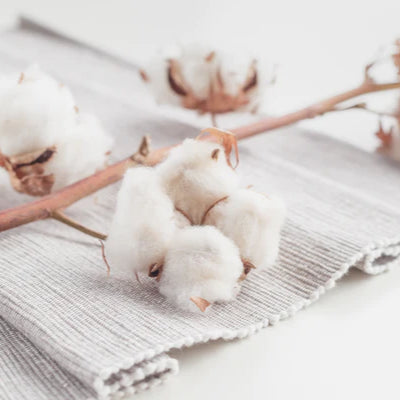The Truth About Cotton
Consumers are inundated with choices. Should my latte be a venti or grande? Are frozen strawberries okay or should I splurge for a fresh batch? Do I wait for the new iphone, or settle for an older, less expensive version? Gone are the days where what you see is what you get.
Nowhere is this more evident than emergence of the term “organic.” As many shoppers have noticed, organic food has been on the rise for years and has introduced a new wave of choices into our daily lives.
Now we’re all faced with the key question: do I buy organic or regular?
The choice here is actually pretty simple, and most shoppers are starting to catch on and educate themselves. Organic affirms an adherence to a natural process, and we buy organic food because it’s healthy and don’t want foreign chemicals invading our bodies. But if you ask those same people who put organic blueberries into their shopping cart if they also shop organic for cotton textiles and clothing, they’ll look at you a little funny. After all, they’re not eating their organic cotton sheets for dinner, so why does it matter? Isn’t it just a label? Actually the answer will surprise you.
Back to basics: Why should we care about cotton?
Cotton is one of the largest and most lucrative crops on the planet. The cotton crop itself is split into two parts: fiber and seed. While the fiber part of the crop is spun into items that we traditionally associate with cotton- like clothing or the soft bedding sheets you climb into every night- the seed part is reserved for making cottonseed oil (used in baking and many foods), livestock feeds, and is also used for replanting the crop.
According to the WWF, cotton represents nearly half of the fiber used to make clothes and other textiles worldwide. That shirt you’re wearing? Probably cotton. In fact, about 73% of cotton crops go into clothing/ apparel, with 18% in home furnishings and 8% into industrial products every year. In the U.S. alone, total economic activity stimulated by cotton is estimated to be over $75 billion. The global demand for cotton has doubled since the 1980’s, now in excess of 25 million tons annually.
You get it. Cotton is a big deal. So let’s go back to the original question, when you’re out shopping, why is it so important that you reach for the organic cotton sheets instead of the traditional set right next to it?
Conventional cotton farming destroys the environment
I shop for organic food because I know how harmful it is to ingest pesticides and other insecticides. How is cotton any different? Remember how cotton is one of the world’s largest crops? Well, cotton uses uses 22.5% of the world’s insecticides and 10% of all pesticides, on 2.5% of agricultural land. That’s an outrageous proportion.
To put that in context, of all insecticides used globally every year, the estimated amount used on cotton is 16-25% more than any other single crop.
Do you know how pesticides affect the environment?
We now know that farmers use pesticides to conventionally farm cotton, but why is that so bad? The chemicals are sprayed onto the crop with the intention of preventing any potential damage to the crop from insects or feeding organisms. But, when sprayed onto the crop, pesticides are often blown into streams or rain water or even seep into the soil directly.

The Aral Sea crisis is a shocking example of what can happen when pesticides leak into our water supply. The once abundant body of water on the border of Kazakhstan and Uzbekistan is now an arid strip of land. Why? In the 1950’s the Soviet Union began using the Aral Sea to irrigate the surrounding agricultural area (cotton farms).
“Conventional cotton (as opposed to organic cotton) has got to be one of the most unsustainable fibres in the world,” says fashion designer and environmentalist Katharine Hamnett. “Conventional cotton uses a huge amount of water and also huge amounts of pesticides which cause 350,000 farmer deaths a year and a million hospitalisations.” (Guardian)
The exposure of the lake has released salts and pesticides into the atmosphere and by 2005, it had lost more than half of its surface area.
Pesticides are harming our ecosystem
Beyond the visible effects of cotton pesticides, biologists estimate millions of birds die every year in the United States from the effects of agricultural chemicals sprayed on cotton and other crops. I mentioned above how sometimes (even properly applied) pesticides can land in runoff water. Now think about the ecosystems inside of that body of water and what happens when they come in contact with the harmful chemicals. The WWF cites a well-documented case in Alabama where at least 240,000 fish were killed by runoff infected with pesticides, even though local authorities state that the chemicals were applied correctly.
Pesticides are harming workers
Pesticides are hazardous by design, so it’s not shocking to discover that farmers who have been in contact with the chemical are seeing a decline in health. Between 1 and 3% of agricultural workers (25 million and 77 million agricultural workers worldwide) suffer from acute pesticide poisoning with at least 1 million requiring hospitalization each year, according to the World Health Organization.
Cotton is more than clothing. It’s food.

In reality, only 35% of total cotton is turned into cloth and the soft, comfy cotton sheets we all love. The rest (the seed), is crushed and separated into a lot of foods that we eat every day.Cottonseed oil is a common ingredient in baking items like crisco. Making cupcakes? You probably used crisco (and cotton!) to grease your tray. Leftover cotton cellulose fibers that are too short to be spun into textiles, like bedding sheets, are used as food additives. Cellulose adds bulk and fiber to food without a major impact on flavor. Because humans can’t digest it, it adds no caloric value. People who eat foods with a high cellulose value feel physically full without adding on the calories.
A fan of pizza? Ice cream? What about salads? Give your thanks to cotton. Cellulose is also a popular additive in foods like cheese, ice cream, and even pre-cooked pasta. So why is this a bad thing? If the cotton crop was farmed traditionally and has been treated with pesticides, there may also be trace elements of pesticides and insecticides on the foods we eat, like cheese and pizza.
Despite its prominence in the foods we eat every day, the Food and Drug Administration (FDA) won’t classify cotton as food. Because it’s not “food”, the Environmental Protection Agency (EPA) allows the use of Aldicarb, one of cotton’s best-selling insecticides. Like I mentioned above, insecticides are dangerous and poisonous to both humans and wildlife, yet 25 countries (including the US) are still using it.
The Promise of Organic Cotton
There’s a lot wrong with the cotton industry, and the choices we make can have a direct impact. The next time you’re out shopping, pay attention to what you pick up. Do you reach for organic cotton sheets, or a regular set? The choice is easy. If cotton is really the fabric of our lives, then don’t we owe it to ourselves to buy organic?







Leave a comment (all fields required)